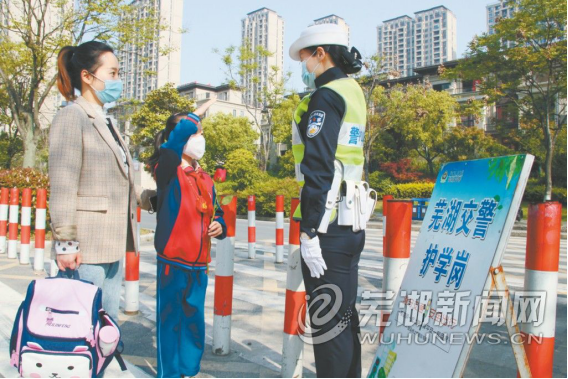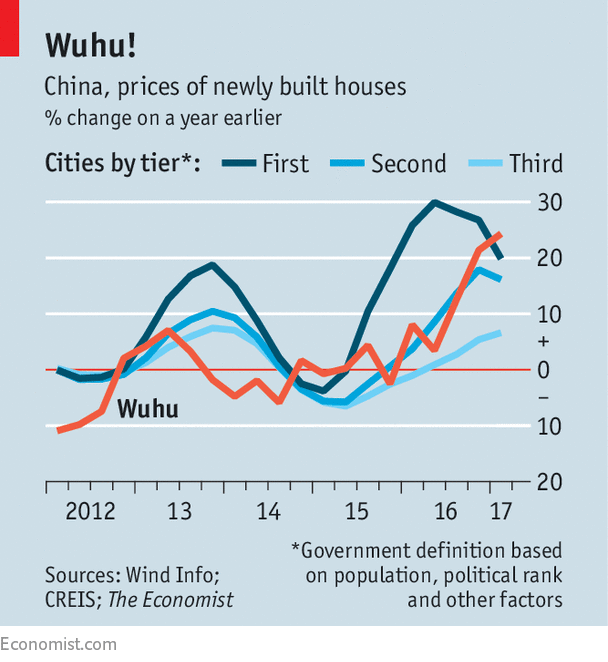Reuters WUHU, CHINA – Wednesday, August 03, 2016 11:00

A robot is presented at Wuhu robotics center in Wuhu, Anhui Province, China, June 30, 2016. Picture taken June 30, 2016.
Down a side street bracketed by massage parlors and cheap hotels in this city on the banks of the Yangtze river, a humanoid food service robot trundles around the corner of a table in a cafe, red eyes flashing in tune with synthesized classical music.
The Wuhu Hands On Café’s waiter, named “Hero,” has no customers on a drizzly Friday morning. He is, though, a symbol of Wuhu city’s hopes of becoming a major center for robotics, and the local government’s ability to chase that dream through the debt markets, whether it makes commercial sense or not.
“Hero” was the result of six months research at a nearby robotics park that has cost 2.2 billion yuan ($332 million) to establish. For the park’s next stage, including a hotel, an exhibition center and a cultural plaza, Wuhu is raising another 1.2 billion yuan through a so-called local government finance vehicle (LGFV), and offering a raft of incentives for firms to set up there.
The problem is it is not alone. Dozens of other medium-sized Chinese cities like Wuhu, which is west of Shanghai in Anhui province and has a population of around four million, have similar robotics park plans.
And the ease with which municipalities can use off balance companies like LGFVs to finance infrastructure – some needed, some not – is rapidly boosting China’s already high debt burden. Meanwhile, investors gambling that Beijing will not allow the debt to default while infrastructure remains a critical support for growth, have bid up LGFV bonds to new highs.
Beijing’s drive to make the nation a leader in robotics through its “Made in China 2025” initiative launched last year has set off a rush as municipalities up and down the country vie to become China’s robotics center.
The investment boom comes as the industry is already showing warning signs of overcapacity, despite increasing demand for robots in auto manufacturing and electronics.
Growth in demand for industrial robots in China fell by more than two-thirds to 17 percent in 2015 – and yet more than 40 robotics parks have sprouted throughout the country in the last two years, according to industry data. In June, the National Business Daily reported Vice Minister of Industry and Information Technology Xin Guobin warning that China’s robotics industry is showing signs of over investment and of “a high-end sector becoming low-end.”
China’s Ministry of Industry and Information Technology had no immediate comment when contacted by Reuters.
Shoring up growth
LGFVs first gained popularity in China in the 1990s as a way to fund municipal projects without running afoul of new restrictions on cities’ official borrowing.
Fireworks explode over a tourist resort in Wuhu, Anhui province, China April 30, 2016.
They played a key role in shoring up economic growth in the global financial crisis but also became a major source of China’s debt burden. Outstanding debt was $26.56 trillion, or 255 percent of gross domestic product at the end of 2015, up from 220 percent just two years before, according to the Bank for International Settlements.
A short-lived crackdown by Beijing on LGFV financing in late 2014 was quickly watered down as growth sputtered to a twenty-five year low last year.
In China as a whole, LGFV bond financing climbed 72 percent in the first five months of 2016 from the same period last year to 740 billion yuan, while the vehicles’ total outstanding bond debt now stands at around five trillion yuan, according to Everbright Securities data sourced from the Chinese information provider WIND.
“Loads of infrastructure-investing companies are exhausting every means they can get to get money,” says Li Yujian at Bohai Trust, which offers high-interest loans to companies who cannot get all the financing they need in mainstream debt markets.
Commanded not controlled
For a command economy, China has a very decentralized fiscal system with local governments responsible for about 85 percent of fiscal spending but receiving only 50 percent of tax revenues. Officials turn to debt to fill the gap.
As a result, Beijing often lacks a clear picture of what local governments are doing, and cities have little reliable data on their neighbors, leading to a dangerous tendency for duplication – especially when Beijing throws its weight behind a given sector, like robotics.
The convoluted work-arounds to funnel cash to oftentimes risky local projects also tend to muddy the question of who is actually responsible should matters go awry.
“We are just a financing platform. We raise money and we lend it out,” says Yang Bin of the Wuhu city-owned Jiujiang Area Construction Investment Corporation, which sold the bonds for the robotic center’s expansion.
The money will be spent by building contractors for the robotics park. There are also local and central government subsidies to attract firms to use the facilities.
The lynchpin of this elaborate edifice remains government backing, implicit and sometimes explicit. Market participants say investing in LGFV debt is essentially a bet on Beijing’s interest in keeping credit flowing smoothly to local governments.
“All of those companies have very weak standard credit metrics. The reason they can borrow is because of local government support, which depends on central government policy,” says Jie Peng of Western Asset Management in Singapore, which invests in some LGFV debt in large Chinese cities.
The support, including a 3.2 trillion yuan Beijing-backed local government debt swap last year, means LGFVs can offer relatively high interest rates while allowing bondholders to feel they are not likely to be heavily exposed to the consequences if investments sour.
The yield to maturity on the Jiujiang Area Construction Investment Corporation’s 1.2 billion yuan bond is 3.8 percent, about 0.5 of a percentage point higher than official local government debt in the same part of China.
To many investors, that looks like a good deal – LGFV debt has outperformed most other corporate debt over the past year as defaults in other sectors have risen.
A participant operates a robot during a competition in Wuhu, Anhui Province, China, June 22, 2013.
The local debt boom, though, has raised fears of a new round of wasted investment. Elsewhere in China, cities are building gargantuan sports stadiums, far bigger than they need; hundreds of amusement parks, many of which do not have the attractions to compete against rivals in neighboring towns; and innovation centers without enough entrepreneurs.
Aspirational start-ups
It is unclear whether the National Wuhu Robotics Park, which currently produces around 1,000 industrial robots a year but plans to boost output to 10,000, will be a success.
Firms are eligible for subsidized rent, subsidized loans, debt guarantees, and monetary awards to attract top talent.
But despite such support, the park contains only a handful of large established enterprises – including Anhui Effort Intelligent Equipment Co Ltd, a major manufacturer of automotive and industrial robots.
Most of the approximately 20 robot manufacturers are aspirational start-ups, or equipment firms hoping to find a new niche. The latter include firms like Anhui Goodluck Science and Technology Co Ltd – which also makes agricultural equipment, chainsaws, and lawn mowers.
Robotics park officials and the Wuhu City Jiujiang Economic Development Zone Committee declined to be interviewed for this article, while a park spokesperson did not respond to an emailed request for comment.
Some of the items under development border on novelties, like “Hero” made by a company called Okayrobot. Besides waiters and military grade segways, Okayrobot is also investing in items as diverse as air conditioned helmets, horizontal showering pods for hospitals and robotic exoskeletons that allow the very old and the disabled to walk.
“Allowing 75-year-old mothers and fathers to live like young people, that is what Okayrobot wants to do,” says general manager Wang Lipeng, gesturing to a PowerPoint showing an exoskeleton-clad man hoisting a woman in his arms, next to another emerging from a fireball.
“The policies here are very good,” added Wang. “And that has drawn the interest of a lot of firms to invest and produce.”




